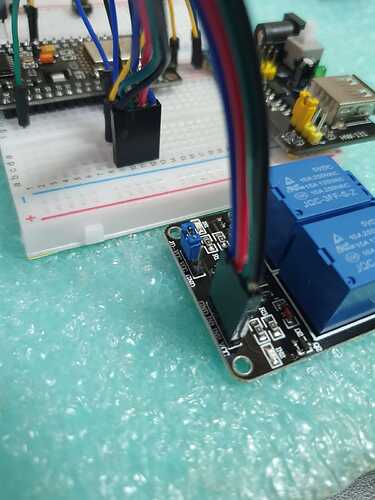Hi guys,
I finally got it working. All I did was changed to Pin 6,7 and in the code changed it to D6, D7. Code seems to be working now. I did not have to use any transistors. I load the code via USB and then unplug and power everything using external power supply. My power supply is set to 5v and feeds relays and the ESP board.
I can trigger relays with voice commands using Alexa. The only item remaining is to add a momentary button to manually trigger relay in case Alexa is on holidays. I have added a momentary button to pin D5 and attached the other side of the button to the ground rail. However, it does not seem to be triggering the relay.
Unfortunately, I have gone over code multiple times without much success. Could someone please give me some pointers?
Thank you for all your help.
// Project for: Alexa Control mains light; + Button
#include <ESP8266WiFi.h>
#define button1_Pin D5
// variables for push button control
byte button1;
byte oldButton1 = 0;
byte button1_state = 0;
#define RELAY_PIN_1 D6
#define RELAY_PIN_2 D7
#include "fauxmoESP.h"
#define SERIAL_BAUDRATE 115200
#define WIFI_SSID "ssid"
#define WIFI_PASS "password"
#define LAMP_1 "Kitchen Light"
#define LAMP_2 "lamp two"
fauxmoESP fauxmo;
// Wi-Fi Connection
void wifiSetup() {
// Set WIFI module to STA mode
WiFi.mode(WIFI_STA);
// Connect
Serial.printf("[WIFI] Connecting to %s ", WIFI_SSID);
WiFi.begin(WIFI_SSID, WIFI_PASS);
// Wait
while (WiFi.status() != WL_CONNECTED) {
Serial.print(".");
delay(100);
}
Serial.println();
// Connected!
Serial.printf("[WIFI] STATION Mode, SSID: %s, IP address: %s\n", WiFi.SSID().c_str(), WiFi.localIP().toString().c_str());
}
void setup() {
// Init serial port and clean garbage
Serial.begin(SERIAL_BAUDRATE);
Serial.println();
// Wi-Fi connection
wifiSetup();
// LED
pinMode(RELAY_PIN_1, OUTPUT);
digitalWrite(RELAY_PIN_1, HIGH);
pinMode(RELAY_PIN_2, OUTPUT);
digitalWrite(RELAY_PIN_2, HIGH);
// Manual button
pinMode (button1_Pin, INPUT);
//*** mySwitch.enableReceive(RF_RECEIVER); // Receiver on interrupt 0 => that is pin #2
// By default, fauxmoESP creates it's own webserver on the defined port
// The TCP port must be 80 for gen3 devices (default is 1901)
// This has to be done before the call to enable()
fauxmo.createServer(true); // not needed, this is the default value
fauxmo.setPort(80); // This is required for gen3 devices
// You have to call enable(true) once you have a WiFi connection
// You can enable or disable the library at any moment
// Disabling it will prevent the devices from being discovered and switched
fauxmo.enable(true);
// You can use different ways to invoke alexa to modify the devices state:
// "Alexa, turn lamp two on"
// Add virtual devices
fauxmo.addDevice(LAMP_1);
fauxmo.addDevice(LAMP_2);
fauxmo.onSetState([](unsigned char device_id, const char * device_name, bool state, unsigned char value) {
// Callback when a command from Alexa is received.
// You can use device_id or device_name to choose the element to perform an action onto (relay, LED,...)
// State is a boolean (ON/OFF) and value a number from 0 to 255 (if you say "set kitchen light to 50%" you will receive a 128 here).
// Just remember not to delay too much here, this is a callback, exit as soon as possible.
// If you have to do something more involved here set a flag and process it in your main loop.
Serial.printf("[MAIN] Device #%d (%s) state: %s value: %d\n", device_id, device_name, state ? "ON" : "OFF", value);
if ( (strcmp(device_name, LAMP_1) == 0) ) {
// this just sets a variable that the main loop() does something about
Serial.println("RELAY 1 switched by Alexa");
//digitalWrite(RELAY_PIN_1, !digitalRead(RELAY_PIN_1));
if (state) {
digitalWrite(RELAY_PIN_1, LOW);
Serial.print("LED should be off");
} else {
digitalWrite(RELAY_PIN_1, HIGH);
Serial.print("LED should be on");
}
}
if ( (strcmp(device_name, LAMP_2) == 0) ) {
// this just sets a variable that the main loop() does something about
Serial.println("RELAY 2 switched by Alexa");
if (state) {
digitalWrite(RELAY_PIN_2, LOW);
} else {
digitalWrite(RELAY_PIN_2, HIGH);
}
}
});
}
void loop() {
// fauxmoESP uses an async TCP server but a sync UDP server
// Therefore, we have to manually poll for UDP packets
fauxmo.handle();
static unsigned long last = millis();
if (millis() - last > 5000) {
last = millis();
Serial.printf("[MAIN] Free heap: %d bytes\n", ESP.getFreeHeap());
}
// Manually trigger Relay using momentary push button
// Read Button
button1 = digitalRead(button1_Pin);
// Following code is used to switch button state. Input is received from a momentary push button.
if(button1 && !oldButton1) // same as if(button1 == high && oldButton1 == low)
{
//we have a new button press
if(button1_state == 0) // if the state is off, turn it on
{
//do stuff
button1_state = 1;
digitalWrite(RELAY_PIN_1, LOW);
Serial.print("LED should be on from Switch");
}
else // if the state is on, turn it off
{
//do stuff
button1_state = 0;
digitalWrite(RELAY_PIN_1, HIGH);
Serial.print("LED should be off from switch");
}
oldButton1 = 1;
}
else if(!button1 && oldButton1) // same as if(button == low && oldButton == high)
{
// the button was released
oldButton1 = 0;
}
}
![]()




